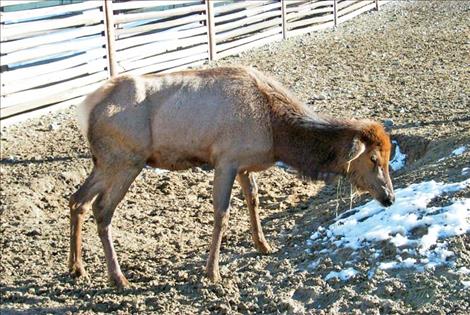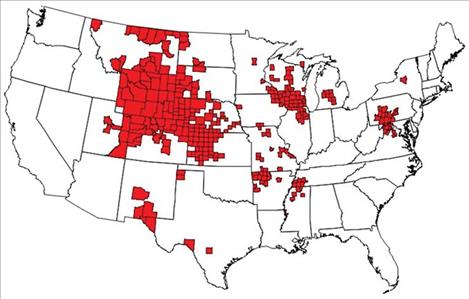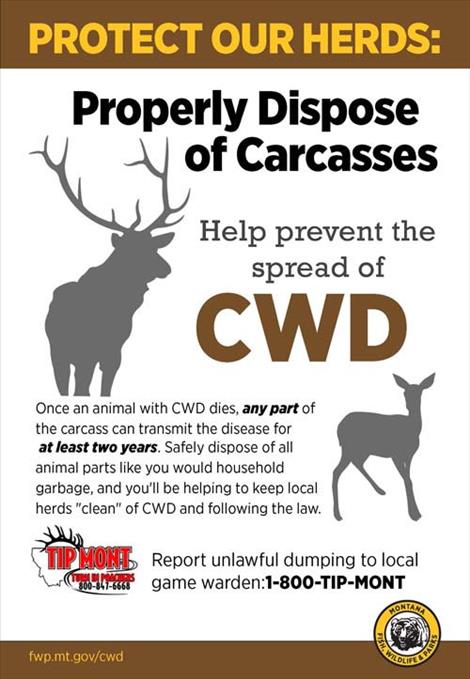Hunters asked to help monitor for Chronic Wasting Disease
Hey savvy news reader! Thanks for choosing local.
You are now reading
1 of 3 free articles.
MONTANA — Chronic wasting disease threatens deer, elk and moose populations in Montana. The spread of the disease is something all hunters should consider as they venture out this fall to harvest wild game.
“CWD is a 100 percent fatal disease that infects members of the deer family, including elk, moose, mule and white-tailed deer,” stated Montana Fish, Wildlife and Parks. “Hunting is the primary tool for monitoring and managing the spread of CWD. Concerns over CWD shouldn’t stop you from enjoying hunting season. Hunters are critical to conservation efforts across the state and protecting our wildlife heritage.”
The Montana Wildlife Federation, the state’s oldest wildlife conservation organization, fights to conserve natural resources and wildlife populations through volunteer work, and they are asking hunters to sign a pledge at montanawildlife.org to help end the spread of CWD. The pledge states: “As a committed Montana hunter, I will do my part to contain the spread and prevalence of Chronic Wasting Disease.”
Hunters are asked to follow several guidelines from the Montana, Fish, Wildlife and Parks to help reduce the spread, including wearing rubber gloves and eye protection when dressing deer and elk. Hunters are asked to minimize the handling of brain and spinal tissue and to avoid the consumption of brain, spinal cord, spleen, tonsils and lymph nodes. “Normal field dressing, coupled with boning out of a carcass, will essentially remove these parts,” MWF states.
Hunters are also asked to properly dispose of carcasses in areas with CWD by burying the carcass, including the head, brain and spinal column of harvested game onsite. “Or bag up those parts and dispose of them in a landfill,” MWF states. “Dispose of CWD positive animals in an approved landfill. Transport only boned meat and cleaned skull caps out of CWD management areas.”
FWP states, as of the fall of 2020, there are not any carcass transport restrictions within the state, and a carcass may be moved anywhere in the state regardless of where it was harvested as long as the parts are disposed of in a landfill after processing.
“Carcass parts, such as brain, eyes, spleen, lymph glands and spinal cord material should be bagged and disposed of in a landfill or may be left at the kill site,” FWP states. “Dumping carcasses is illegal, unethical and can spread diseases, including chronic wasting disease. This new requirement applies to all deer, elk, and moose carcasses wherever in the state they are harvested by hunters or as vehicle-killed salvage. Protect our herds: properly dispose of carcasses.”
People are also asked to report any sightings of deer, elk or moose displaying signs of CWD. The symptoms include lethargy, cognitive loss, confusion or emaciation. Hunters are asked not to harvest animals that appear ill.
FWP designated certain areas of the state as Priority Surveillance Areas. A high priority area is located around Libby, where positive tests were found for CWD, and extends from the state’s northern border to the edge of the Flathead Reservation.
Hunters are asked to voluntarily submit samples from their animal. Montana hunters can have their deer, elk or moose tested for CWD with help from FWP, who pays for the testing. CWD testing is voluntary.
“In Priority Surveillance Areas, sampling is strongly encouraged to help FWP gather additional data to inform management,” FWP states. “Hunters can take samples themselves, fill out the online hunter submission form and mail them to our Wildlife Health Lab in Bozeman or bring the animal (head) to an FWP regional office or CWD Sampling Station. Testing labs will test an animal’s retropharyngeal lymph nodes or brainstem for evidence of CWD. Hunters can request a replacement license if their animal tests positive for CWD. “Unfortunately, there are no non-invasive CWD tests for live animals. Meat cannot be tested for CWD.”
Sampling stations will be set up state-wide during the general hunting season. The regional headquarters in Kalispell is located at 490 North Meridian Rd., 406-752-5501. The headquarters for region two in Missoula is located at 3201 Spurgin Rd., 406-542-5500. The Confederated Salish and Kootenai Tribal Natural Resources Department can check deer, elk and moose at 406 Sixth Ave. East in Polson, call 406-883-2888 ext. 7242 for more information.
“CSKT hunters are asked to participate in the CWD testing that the Tribal Wildlife Management Program will be conducting again this year,” the Natural Resources Department states. “It is important to keep the head cool or frozen, moose heads with second vertebrae are required to take an adequate CWD sample. Samples will be sent out weekly and hunters will be contacted with the results.”
According to FWP, the origin of CWD is unknown. The disease was first discovered in a mule deer at a research facility in 1967 in Colorado. The first free-ranging deer in Montana with CWD was detected in October of 2017. The disease was found in the state in captive game farms in Montana in 1999 and again in 2020. The disease hasn’t been documented on the Flathead Reservation, but it has been found in other areas in Montana where hunters


















